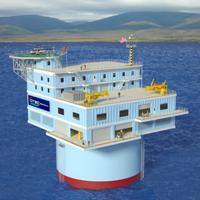ABS Provides First Approval in Principle for Floating Renewable Energy Plant
 ABS has issued its first Approval in Principle (AIP) for a new concept renewable energy design in which a moored spar uses ammonia in a closed-cycle process to produce electrical power for a commercial utility grid. Unlike wind, tidal or solar power the advanced design for this Ocean Thermal Energy Conversion (OTEC) system can deliver constant output 24 hours a day. “This concept combines proven offshore principles with off-the-shelf power.”
ABS has issued its first Approval in Principle (AIP) for a new concept renewable energy design in which a moored spar uses ammonia in a closed-cycle process to produce electrical power for a commercial utility grid. Unlike wind, tidal or solar power the advanced design for this Ocean Thermal Energy Conversion (OTEC) system can deliver constant output 24 hours a day. “This concept combines proven offshore principles with off-the-shelf power.”
Furthermore the concept combines proven offshore principles with technology and proprietary innovations”, said Ian Simpson, ABS director of Offshore Technology and Business Development Americas Division. He continued: “All the aspects of the concept are assembled in a unique way. The design application illustrates how ABS is able to use its novel concept approach and guidance to provide review of a concept within the framework of established safety standards.”
Approach
Developed by OTEC International (OTI) LLC of Baltimore (Maryland), the approach converts liquid ammonia into gas in a heat exchanger using warm ocean surface water. The ammonia gas then drives turbines that turn generators to produce electricity which is then exported through a submarine power cable to a land-based utility company. The ammonia is condensed back into a liquid phase using cold ocean water pumped from 3,000 ft below the water’s surface and the process begins again. The process is based upon the well-established thermodynamic Rankine cycle.
OTEC Power Block
“OTI has integrated the OTEC power block into a large floating vessel, in this case a spar, for an economically and environmentally-efficient means of converting solar energy from the tropical oceans into affordable electricity”, explains Barry Cole, OTI’s executive vice president and director of Technology Development.
Key Elements
Key elements evaluated by ABS include spar hull sizing for the deep draft spar design, energy conversion equipment located in the spar, handling and storage of hazardous materials, deepwater mooring system, cold water pipe conduit suspended from the base of the spar, construction and attachment of the cold water pipe conduit and power transmission cable with its securing, anchoring and suspension arrangements. ABS reviewed the design for an extended 30-year facility on-station life.






